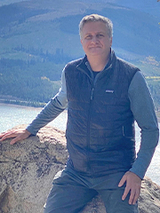Pulmonary Heart Valve Replacement as an Adult: Russell’s Story
Pulmonary Heart Valve Replacement as an Adult: Russell’s Story
From undergoing a corrective surgery for tetralogy of Fallot (TOF) at a young age to receiving a novel heart valve in his late forties, Russell has always been among the first to receive cutting edge heart care. This time, the most innovative care could only be found in a pediatric hospital.

When Russell was born 51 years ago with TOF, a congenital heart defect that limits the heart’s ability to pump oxygenated blood throughout the body, it was standard practice to delay repair until young adulthood, when a patient’s heart had reached its full size. However, Russell’s family lived near a Minnesota hospital that had just begun performing corrective repairs of TOF on younger children. One of the first, Russell underwent surgery at 4 years old.
Commonly called a ‘tet repair,’ surgical treatment for TOF requires open-heart surgery to patch the hole (ventricle septal defect) in the heart and widen the pulmonary valve or artery. Though Russell grew up with a lengthy scar, he now feels fortunate that he was able to receive the repair. “I was born with a condition that normally would’ve affected my first 19 years of life,” he says. “But I pretty much had a normal childhood.”
Russell received follow-up care in Philadelphia, where his father worked as a physician for the Hospital at the University of Pennsylvania. At CHOP, William Rashkind, MD, now widely considered “the father of interventional cardiology,” led Russell’s care team. “He used to take me on rounds because at that time it was so rare for kids to have had a tet repair,” Russell remembers. “Now the surgery is done on babies.”
Adult heart care
More About TOF
Russell went on to attend college, play lacrosse and become a lawyer. He also continued to receive care from an adult cardiologist. Like most adults who undergo a TOF repair in childhood, Russell knew he would eventually need another surgery. Long-term pulmonary regurgitation after tet repair will cause the right side of the heart to enlarge and affect heart function.
When, several years ago, Russell moved back from Texas to Pennsylvania, he began to see Emily Ruckdeschel, MD, an attending physician with the Philadelphia Adult Congenital Heart Center, a program providing care for adults with congenital heart disease through a collaboration of CHOP and the Penn Medicine Health System. Though Russell had long ago begun preparing himself for the possibility of another open-heart surgery, Dr. Ruckdeschel had good news: pulmonary valves could now be replaced using a minimally invasive transcatheter approach. The procedure requires less anesthesia, reduces the risk of infection, and leads to a faster recovery.
Dr. Ruckdeschel referred Russell to Matthew J. Gillespie, MD, Director of CHOP’s Interventional Cardiology Program, Co-director of CHOP’s Topolewski Pediatric Heart Valve Center, and a world leader in innovative cardiac catheterization procedures. Dr. Gillespie, Russell was thrilled to discover, had been heavily influenced and inspired by his childhood provider, Dr. Rashkind. Unfortunately, an evaluation of Russell’s heart showed that the currently approved transcatheter pulmonary valves were not the size Russell needed. The right device — the Harmony™ Transcatheter Pulmonary Valve (TPV) — was in clinical trials awaiting FDA approval.
As time passed, Russell began to experience fatigue and was unable to finish his typical workouts. His care team agreed: Russell needed surgery, and soon. He began to prepare for the open-heart surgery and recovery period that would disrupt his life for months.
A life-changing phone call
In 2019, Russell was in Washington D.C., helping a colleague prepare an argument for the Supreme Court when he finally received the call he’d been waiting for: Russell had been accepted into the Harmony™ TPV clinical trial and could schedule his procedure as soon as possible.
On the day of the procedure, near Halloween, Russell and his fiancé arrived at CHOP early in the morning. The short procedure with only one overnight stay made Russell one of the first patients to receive the new valve.
“I grew up around doctors and hospitals,” Russell says, noting that it was a little “weird” to be an adult in a pediatric hospital, but he enjoyed having his own room and joking with the staff. “The nurses were really great. It was a wonderful experience.”
A quick recovery

Unlike the month-long recovery of an open-heart surgery, Russell’s recovery was brief. He began to take short walks in his first few days home and was back at work by the end of the week. Within a month, Russell was back in the gym.
“I felt great soon after,” he says. “And I still do.”
Russell continues to see Dr. Ruckdeschel as his primary cardiologist and also follows up regularly with Dr. Gillespie. Because the replacement valve is made of tissue from a pig’s heart, it will eventually deteriorate, and Russell will need a new valve. Though this will hopefully not be necessary for another ten years or even longer, Russell trusts that when another valve replacement is needed, it will be just as simple as this one, if not more so.
“I’ve been very lucky each step of the way — fortunate to be in the right place at the right time. Who knows where things will be in five or ten years? Probably even better.”